
An unexpected video posted on the Jezebel.com has gone viral in the last 24 hours. The moving clip highlights the  story of 23-year-old Harnaam Kaur from Slough, UK who has a full beard. Harnaam’s polycystic ovary syndrome led to her facial and body hair growth as a pre-teen, resulting in intense bullying and harassment from her peers. Harmaan took amrit as a 16-year-old, proudly embracing her Sikh identity and her unshorn hair — facial hair included.  It seems the teenage Harnaam found the strength to overcome years of isolation and self-loathing in part through Sikhi.
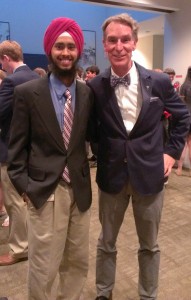 Blogged by Harjit Singh
Blogged by Harjit Singh
Many people who know me wonder why as an astrophysics and geophysics major I interned in the office of Congresswoman Judy Chu. In her office I have was not only able to explore my interests, but I also served my Sikh community and built a network of friends and mentors who will likely be there for me as I ready to launch in the world- post- undergrad.
As an astrophysicist, I was assigned to conduct research on NASA’s priorities and goals. I read the Congressional Research Survey Reports about NASA, attended hearings on the topic of NASA reauthorization, and wrote memos summarizing those hearings. The internship helped me to understand the future of space exploration and become somewhat of an expert in the policy aspect of this field.
One of the highlights was meeting Bill Nye at a NASA event I attended through my internship. This man helped many kids fall in love with science so meeting him was inspirational.
In terms of advancement of Sikhs, I believe I contributed to the cause during my time in D.C. First, it was a positive step adding to the diversity but specifically increasing the Sikh presence and visibility in the city, especially on Capitol Hill. Even in a city filled with graduate and professional degrees, there remains much ethnic and religious ignorance. Luckily, I had the opportunity to dispel some of that ignorance through my daily interactions with people. Also, with Judy Chu being a co-chair of the American Sikh Congressional Caucus, I worked on a few cool things for the caucus. My most important contribution would have to be writing the first draft to a resolution (H.Res. 334) that was introduced in Congress to commemorate the anniversary of the shootings at the Oak Creek Gurdwara.
Co-blogged by American Turban and Sundari

San Quentin State Prison, California. (Image: San Quentin News.)
The Sikh Coalition, a civil rights organization, was recently asked to present to a group of inmates at San Quentin State Prison in Northern California.  Organized by the Asian Prisoner Support Committee, which has a weekly class inside San Quentin State Prison called SQ ROOTS (Restoring Our Original True Selves), the organization was asked to make a presentation about the Sikh community.  The class is modeled after Asian American Studies courses, covering topics such as history, culture, personal experiences as well as health and reentry issues.  The class is comprised of Vietnamese, Filipino, Cambodian, Hmong, Lao, Chinese, Mexican in addition to Punjabi Sikh men.
The presentation included a Sikh awareness talk followed by a discussion on the post-9/11 challenges experienced by the Sikh community, including hate crimes, school bullying, religious profiling and workplace discrimination.  It was a unique experience for both the Sikh Coalition volunteers as well as the inmates who noted at the end that they were “grateful†and “thankful†to have learned about the Sikh community and the issues that Sikh Americans were experiencing.  It was a moving experience and pushed us to think about restorative justice and the role of forgiveness within Sikhi.
Many of us on the “outside†have preconceived ideas about what life is like inside the prison system. To be sure, our few hours inside the prison and interacting with the inmates may not be a fully representative view of prison life. Yet, the warm reception we received by inmates before, during, and after our session was eye-opening; the inmates in our class were very engaged, courteous and collegial. We enjoyed the positive and warm atmosphere exuded by each member of our audience, and were touched by the obvious desire by these inmates to learn more about the Sikh community, and to even empathize with some of the issues that Sikhs in this country have faced.
A few weeks ago, the Indian Supreme Court re-criminalized sexual acts between consenting adults of the same sex. The Supreme Court  overturned a 2009 decision by the Delhi High Court to strike down section 377 of the Indian Penal Code, which came directly from a British colonial law from 1861. Section 377, which was just reinstated, states:
overturned a 2009 decision by the Delhi High Court to strike down section 377 of the Indian Penal Code, which came directly from a British colonial law from 1861. Section 377, which was just reinstated, states:
377. Unnatural offenses — Whoever voluntarily has carnal intercourse against the order of nature with any man, woman or animal, shall be punished with imprisonment for life, or with imprisonment of either description for a term which may extend to ten years, and shall also be liable to fine.
As Prerna Lal states about the recent ruling, “the Indian Supreme Court has re-criminalized gay sex in India, rendering almost 20 percent of the global LGBT population illegal.” As a result, LGBT Indians and their allies in India and around the world have taken to the streets, signed petitions, and engaged in creative actions through social media, showing their outrage about this backwards decision.
But what has the Sikh response been? I have previously written about the homophobia rampant in our community and how ironic it is, given our Gurus’ deep commitment to equality and social justice. In the days after the ruling on 377, I wondered if any Sikh activists committed to LGBT equality would come out of the woodwork. I also wondered about the Sikh response to the ruling in India and if any Sikh institutions publicly supported or lobbied for this ruling. Embarrassingly, Sikh institutions have publicly campaigned against LGBT equality in the past, including supporting the Defense of Marriage Act (DOMA) in the US a few years back.
Enter Kanwar Saini, aka Sikh Knowledge, a young, openly gay hip hop artist in Toronto. In protest of 377 and as a part of a social media campaign, Saini posted a photograph of him kissing another man on Facebook, which went somewhat viral and led to a lot of discussion and debate about Sikhi and gay rights. Facebook removed the photo from his page for 16 hours, quite possibly due to a whole lot of homophobic Sikhs reporting the picture to Facebook as offensive.
Saini recently appeared on CTV discussing the incident and his response.
The Best:
-
Bhai Gurbaksh Singh went on a hunger strike for 44 days which led to the release of 4 political prisoners and increased international attention on human rights in India. We were all deeply moved and inspired, and Bhai Sahib sparked a new movement!
-
Sikh women claimed their place in new and outstanding ways!
-
Balpreet Kaur gave this inspiring talk. We all love her.
-
SAFAR held it’s second annual Young Women’s Leadership conference, took us beyond International Women’s Day and shared a beautiful message on the International Day of the Girl.
-
The Sikh Coalition acknowledged International Day of the Girl for the first time.
-
The Sikh Activist Network featured poems about rape in India.
-
Sikhnet hosted an online youth film festival focused on KAUR. How amazing is that?!
-
The Sikh Art & Film Festival added a female speaker to their panel and 18MillionRising stepped in to support gender equality.
-
My awesome friends are building a Dastaar Tutorial Project for women (more details to come soon). Maybe now I can figure out how to keep a patka on my head that doesn’t slip off underneath my dastaar. Win!!!!!
-
-
We marked the one-year anniversary since Oak Creek and grieved several other hate crimes but still came out on top.
-
Piara Singh was attacked in Fresno and the community rose to the occasion in inspiring ways, serving meals and buckets full of compassion to local families.
-
Dr. Prabhjot Singh invited his attackers to worship with him and shifted the narrative of justice when it comes to hate crimes.
-
The Sikh Coalition released a new version of Fly Rights. Rockin it!
-
Jasjeet Singh spoke at the 50th Anniversary of the March on Washington. No big deal.
-
Dr. Kiran Arora began a study on religion and race-related stress among North American Sikhs. Much-needed.
-
Turban Myths was released, the first national public perception assessment on the Sikh American community, conducted by SALDEF in collaboration with Stanford University. Nicely done! Continue Reading »
-
Guest blogged by Kirpa Kaur
A few weeks ago, India joined the world in mourning the loss of Nelson Mandela, the former South African president and anti-apartheid revolutionary whose armed resistance and leadership rendered him a “terrorist†and imprisoned for 27 years. Prime Minister Manmohan Singh stated: “A giant among men has passed away. This is as much India’s loss as South Africa’s. He was a true Gandhian. His life and work will remain a source of eternal inspiration for generations to come.â€
It’s been 44 days since a Sikh farmer and activist from Haryana decided to launch a hunger strike unto death at Gurudwara Amb Sahib (Mohali, next door to Chandigarh) to protest the long sentences being served by political prisoners who have been denied any legally mandated review of their cases; and India remains largely silent. BBC Radio yesterday recognized that while the protest has caught momentum around the world, and from various quarters in Punjab, including the oft-vilified Punjabi singers, mainstream India is largely aloof on this issue.
Guest blogged by Jaspreet Kaur
There has recently been a lot of stir in the Sikh community about the GAP’s new “Make Love†holiday campaign. The Gap used Waris Ahluwalia, a Sikh actor and designer, as a model for one of their promotional pictures. The response from the Sikh and non Sikh community was mixed and social media started buzzing with reactions to the image. A large add of this picture in New York City was recently vandalised and the Gap immediately responded by changing their twitter background to the image. Once again, the Sikh community responded, this time with more positive comments and support for the Gap.
What seems to have been forgotten in all this commotion is that the Gap is a multinational corporation that is only about their bottom line. They are about making money, not love. Their primary interest is to sell a product and by claiming to capture and commodify love, they are selling clothes. While the Gap is being praised for their quick response time and progressive thinking what is dismissed is the understanding that by the time a corporation uses an idea, it is no longer revolutionary. Gap would not have used a Sikh model if it hurt their bottom line. It is already acceptable and that is why the Gap can profit from displaying a turban and beard.
Op-Ed printed in The Harlem Times Nov/Dec Issue
White supremacy typically evokes images of Klansmen on night rides setting homes ablaze with burning crosses or white policemen hosing down African American protesters during the civil rights movement. However, white supremacy is also what led a group of black teenagers to violently attack a Sikh man in Harlem this September. Given that the attackers are not white, how then is white supremacy related?
Early reports indicated that a group of 15-20 young boys assaulted Dr. Prabhjot Singh yelling “Terrorist†and “Get Osama,†leaving him with several injuries including a fractured jaw. What Dr. Singh experienced is not an isolated incident. Though violence against Sikhs has increased in the last 10 years and some attribute this to 9/11, it is part of a much more complex narrative that pre-dates 9/11: long-standing histories of oppression and genocide of Sikhs in pre-colonial and post-colonial India as well as systemic racism in the U.S. Media reports of the attack against Dr. Singh have followed an almost prosaic plot, identifying post 9/11 backlash, Islamophobia, racial profiling and misidentification as the usual suspects but failing to address white supremacy as a root cause in both the past and present.
Though police have not yet identified the attackers, accounts from Dr. Singh and eyewitnesses intimate that his aggressors were young black boys. When Melissa Harris-Perry interviewed Dr. Singh, she remarked on her surprise that his assailants represent a group also targeted by racism. However, it is precisely their experience as targets of racism which likely motivated them. Black males continue to be targeted and profiled as dangerous or unsafe or less competent at work and school, as evidenced recently by the NYPD’s use of stop and frisk tactics and the murder of Trayvon Martin. Historically, groups systematically targeted by racism scapegoat other groups that pose real or perceived threats. During the founding years of the United States, divisions between communities began when slavery and colonialism were the reality of white on black relations. Tensions between people of South Asian and African heritage have an equally long history, spanning the 19th century when Indians first immigrated to Africa and the U.S. Lastly, race still defines our society, the way we see ourselves and other groups of people as it has for centuries though now in a more diverse context.
In many ways, what Dr. Singh experienced was similar to the way Irish, Jewish and Japanese immigrants were scapegoated in the 19th and 20th centuries in the U.S. Continue Reading »
BREAKING NEWS: The Sikh Art and Film Foundation has responded by including a female speaker in next week’s Leadership Summit!!! Great progress. Â Yet, the lack of representation of women and girls from 2004 – 2012 in the film festivals and galas still needs to be addressed, and this is a community wide issue. Â See below for actionable solutions.
Via Email:
November 15, 2013 7:43PM Nina Chanpreet Kaur,
Dear Sikh Art and Film Foundation,
I am very glad to see that Rashmy Chatterjee will be speaking at next Friday’s Leadership Summit.  This is a tremendous gain for our community as most of the speakers at the summit have been men since 2011.  This represents a trend in many Sikh organizations I hope we can change together. As a Sikh woman and resident of NYC for the last 11 years, I have followed your organization since it’s inception.  Over the years, I have attended many of your events and have been so inspired by the films, speakers and attendees.  I have also noticed the lack of representation of women and girls in your programs.  Though you took a step forward this week, I believe you could be doing more to address, highlight and celebrate the challenges and triumphs of Sikh women and girls whether in your Film Festival, Heritage Gala or Leadership Summit.
I understand that your goal is to transcend the dichotomies and binaries of gender and other categories to sustain the universality and equality that our Gurus envisioned in order to promote and preserve Sikh and Punjabi heritage. Â I share your vision and do not condone a gender binary or bias towards either men or women. Â I am also aware that you face limitations as all organizations do, in particular that you must base the selections of films on the submissions you receive. Â However, Sikh men and boys have been a central part of your programs in a way Sikh women and girls have not and this indicates a bias – whether intentional or not.
From 2007 to 2012, none of your Gala awards for Leadership and Vision have been presented to Sikh women. Â In fact, the only women who received awards were for Creativity/Art with the exception of Shonali Bose who received an award for Courage and Shelley Rubin who received an award for Leadership jointly with her husband. Â For 5 years in a row you have only presented Sikh women with awards for Creativity/Art and no other category. Â As a Sikh woman, this sends a message to me and the next generation of Kaurs that women can be honored for creativity and art but not for leadership and vision. Â It raises questions about your beliefs and assumptions related to gender roles and women’s capacities in relation to men. Â This is most certainly not the message young Kaurs should be receiving, nor do I think this is your intention based on the email I received from Ravi last week. Â Â Â Â Continue Reading »
 There are only a few days left in the annual SikhNet Youth Online Film Festival. Â This year’s theme, “onKaur: Focusing the Lens on Women”, brings together a collection of 18 films by and about Sikh women. Â The films look at the idea of “Kaur”, what that means and how it can be represented in film.
There are only a few days left in the annual SikhNet Youth Online Film Festival. Â This year’s theme, “onKaur: Focusing the Lens on Women”, brings together a collection of 18 films by and about Sikh women. Â The films look at the idea of “Kaur”, what that means and how it can be represented in film.
The films have been categorized as documentary (“think”) and drama (“cry”) with issues including: Anand Karaj, bullying, hair, health issues of Panjab, gender justice, family, and gatka among others.
The film festival is important for several reasons and this year’s theme brings to light the need to include Sikh women’s voices in conversations around identity and community. Â It’s a valuable way of showcasing issues affecting Sikh women.
Here’s how to view and vote:
The film festival also provides a platform for young filmmakers to showcase their films to a wider audience.
1. View the documentary films here and vote via Facebook.
2. View the drama films here and vote via Facebook.
Voting ends on October 9th.
Guest Blogged by Jaideep Singh
As the Sikh American community embarks yet another mobilization against hate attacks— since this latest episode of violence has really hit home with many Sikhs in a way rarely seen since Balbir Singh Sodhi— we would do well to first answer the difficult, necessarily critical questions posed by my sister Nina Chanpreet Kaur in her thoughtful, passionate piece from last year.[1]
Our efforts at “education and outreach†clearly have yielded perilously little success— as measured by the safety of our communities. So education obviously is NOT enough. Reality is far more complex and ugly. A person who would attack a gurdwara is not coming to an open house or community feeding (langar) to abate their hatred. The long list of those in our communities who have been injured and killed, and the homes and gurdwaras defaced, testifies to as much. We cannot advance by hiding in our gated communities, far from the raw racial realities daily faced by our less fortunate sisters and brothers.
Fighting centuries of entrenched, utterly irrational white [and Christian] supremacy is neither an easy task, nor a short term one. Many of us cannot even bring ourselves to admit these forces even exist, let alone how they permanently define Sikhs as racial and religious outsiders. That naïve approach must end, replaced by a sophistication borne of serious historical study of U.S. history.
Sometimes I wonder where 1984 went
Sitting across the dinner table from my parents
Frozen
Me stuck at the age of 1
The annihilation of my mind
I touch my long braid to make sure it’s still there
My brothers dressed as girls to pass through another village for safety
Terror rises
And I dance
Making ancient sounds with my body
Slapping my heels against bare earth
Raising my arms then spinning
I look down at dirty red brown
Guest blogged by Simran Jeet Singh
Last night, I received the kind of phone call that everyone dreads: a close friend was hurt, and on his way to the hospital. But the news got worse, as I learned that my friend, Dr. Prabhjot Singh, a young Sikh American professor at Columbia University, had been brutally attacked on a public street, the victim of a violent hate crime. My brother and I immediately jumped in a taxi and rushed to the hospital, where we finally saw Prabhjot being wheeled in, bloody and bruised, his face swollen from a fractured jaw. He couldn’t speak because many of his teeth had been displaced, but he waved limply to let us know that he was okay.
We joined Prabhjot in his hospital room and were surprised to find it already filled with officers from the NYPD and its Hate Crime Task Force. As he struggled to give his statement, we came to learn that his assailants had taunted him as they beat him, calling him “Osama” and “terrorist.” He described being punched in the face repeatedly until falling to the ground. And then he recalled how the punches to the head continued as he laid on the sidewalk.
I saw Prabhjot shudder as he realized how much worse it could have been. He had just returned from dinner, dropping his wife and one-year-old son at home before going for a walk. He reached from his hospital bed and grabbed his wife’s hand.
He recounted the scariest moment, seeing a young male put his arm inside his coat, as if reaching for a gun. He also remembered people pulling at his long beard. He couldn’t provide any descriptions about his assailants, and it seemed to me that in some way, he didn’t want to remember them.
Prabhjot has dedicated his life to serving the underserved. He is currently the Director of Systems Management at the Earth Institute, and he draws upon his experiences abroad to help improve the health of local communities like Harlem. In addition to serving as an Assistant Professor at Columbia University’s School of International and Public Affairs, he is also a resident physician at Mt. Sinai Hospital. His life’s work has been to help the underprivileged access quality and affordable healthcare, and he believes strongly that his countless hours of service are an investment in improving the health of impoverished communities.
Quebec is at it again. Just a few months after the Quebec Soccer Federation reversed its ban on turbans and other religious headwear on the field after a whole lot of public outcry, officials in Quebec have introduced a proposal to ban “conspicuous religious symbols” from public sector workplaces. These so-called symbols include the turbans, hijabs, and even yarmulkes.
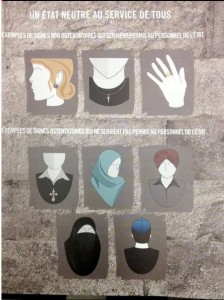
The proposed policy in Quebec would allow public service employees to wear the kinds of “symbols” on the top row but not the bottom five.
The proposal is drawing lots of criticism, including from federal government officials in Canada. Minister of Employment, Social Development and Multiculturalism Jason Kenney stated, “we are very concerned about any proposal that would discriminate unfairly against people based on their religion and based on their deepest convictions,” and promised to put any law that passes through constitutional review.
Ironically, two years ago, Kenney, not particularly concerned about people’s deepest spiritual convictions, announced a ban on burqas from citizenship ceremonies, citing women’s liberation as part of the justification. The new proposed policy in Quebec also includes a burqa ban:
The proposal also requires people receiving state services “to make their faces completely visible,” a measure aimed at banning the burqa, a traditional head-to-toe garment worn by some Muslim women.
Quebec premier Pauline Marois had told a Quebec newspaper that, for her, a day care teacher wearing a head scarf carries a “connotation of a certain gap between the respect of equality between men and women, of a sort of submission.” (link)
A recent BBC article titled, “Is there a Sikh code of silence on sexual grooming?” discusses how six men were jailed in the UK for offences including child prostitution – the case receiving significant attention since it was the first high-profile case involving a Sikh victim of sexual abuse leading to convictions.  As a follow up to the article, BBC’s Inside Out London showcased a 30 minute report uncovering the “hidden scandal of sexual grooming of young Sikh girls by Muslim men.”  The show is receiving much attention – particularly within the Sikh community – with much discussion around the tense issue, race relations and what’s being done (or not) to address the problem.
The documentary (which you can view below) showcases real cases where girls courageously discuss their experiences being “groomed” and forced into prostitution. Â Sexual abuse is a serious issue within many communities, the Punjabi community is no exception. Â Unfortunately, a lack of openness to talk about the issue often leaves victims and their families living in isolation. Â The report identifies the work of an organization within the UK called the Sikh Awareness Society that provides some assistance to these young girls and often bringing to light the criminal activity which local law enforcement agencies often neglect. Â The organization has committed to traveling to all the Gurdwaras in the UK to provide information about the issue and to help parents understand what their children may be experiencing. Â While it is unclear how large the issue really is or how long it has been occurring – it is nevertheless significant that this discussion is even taking place (especially in Gurdwaras!).
I found the report to be troubling for several more reasons.
Guest blogged by Shahe Kaur
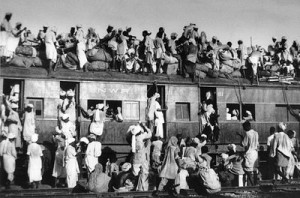 On the eve of India’s Independence Day, it is difficult to not think about the haunting stories I have heard from my parents, grandparents, and others who lived through the horrific partition of India into azaad (independent or free) India and Pakistan. This partition uprooted over 10 million people and resulted in murders and brutality far too numerous to count with official accuracy, with estimates ranging from a few hundred thousand to a few million.  Many of us will likely never truly understand how much our elders are haunted by the memories of forced migration, murder, and the other atrocities that occurred when they had to uproot to the newly independent India.
On the eve of India’s Independence Day, it is difficult to not think about the haunting stories I have heard from my parents, grandparents, and others who lived through the horrific partition of India into azaad (independent or free) India and Pakistan. This partition uprooted over 10 million people and resulted in murders and brutality far too numerous to count with official accuracy, with estimates ranging from a few hundred thousand to a few million.  Many of us will likely never truly understand how much our elders are haunted by the memories of forced migration, murder, and the other atrocities that occurred when they had to uproot to the newly independent India.
As a child and throughout the time I spent with my grandmother,  I was very interested in the history of who I was and where our family came from. However, when it came to topics like partition or the atrocities that occurred in 1984, my family, particularly my grandmother did not want to talk about it. The memories were far too painful for my grandmother to ever completely tell me her story. “ Those days have passed, let them be,†was the common response that I got. Of course the vakeel (lawyer) in me, even as a child, could just not let things be. I had to know more about who we were as a family and the history that is part of the fabric of who I am today. As I pushed and pushed for more details regarding my grandmother’s journey, I began to piece together an image of the atrocities she witnessed and endured to become the woman that I knew. As she would tell me her story, each time proclaiming she had told me the same story a hundred times before, I probed more and more to gain more of her experience and account of what she had endured. Eventually she told me all that she cared to speak of, which was enough for me to get a glimpse of how deep her courage, strength, and love for her family truly was.
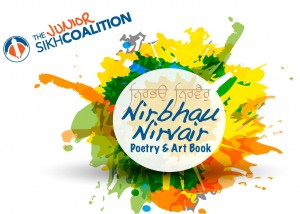 The Junior Sikh Coalition is an initiative of the Sikh Coalition to help develop leaders in local communities, providing young Sikhs with experience in organizing, advocacy, diversity education and civil rights.
The Junior Sikh Coalition is an initiative of the Sikh Coalition to help develop leaders in local communities, providing young Sikhs with experience in organizing, advocacy, diversity education and civil rights.
In a new project, the Junior Sikh Coalition is harnessing the power of art in advocacy with an unprecedented art collection called the Nirbhau Nirvair Poetry & Art Book to bring attention to issues such as bullying and hate crimes. Young Sikhs across to country are invited to submit their art, poetry, and photographs, to showcase their perspective on the concept of Nirbhau Nirvair (“without fear and without hatred”), as first proclaimed by Guru Nanak in Jap Ji Sahib.
Find out more below about this unique opportunity for young Sikh artists.
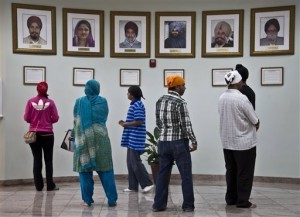 Last August, a gunman walked into a Gurdwara in Oak Creek, Wisconsin, leaving six dead and several injured. Â It was a day that is etched into the minds of Sikhs around the globe. Â While we would like to think that this tragedy is seen as an American tragedy, the mass shooting in Oak Creek did not receive the same media or government attention that other similar tragedies received. Â What many Americans don’t know is that the Oak Creek mass shooting was the most lethal attack on an American house of worship since the 1963 bombing of the 16th Street Baptist Church in Birmingham, Alabama.
Last August, a gunman walked into a Gurdwara in Oak Creek, Wisconsin, leaving six dead and several injured. Â It was a day that is etched into the minds of Sikhs around the globe. Â While we would like to think that this tragedy is seen as an American tragedy, the mass shooting in Oak Creek did not receive the same media or government attention that other similar tragedies received. Â What many Americans don’t know is that the Oak Creek mass shooting was the most lethal attack on an American house of worship since the 1963 bombing of the 16th Street Baptist Church in Birmingham, Alabama.
Nevertheless, we push forward with our Sikh spirit intact. Â In light of this, communities across the nation are coming together to remember the victims and survivors of the Oak Creek mass shooting. Â Here is a list of various events taking place both locally in Oak Creek and nationally.
The Chardi Kala 6K Memorial Run & Walk will be taking place on Saturday August 3rd in Oak Creek, WI.  The event will be a community gathering honoring those we lost on August 5, 2012, as well as celebrating all that has been done to bring the community together.  More information can be found here.
The Oak Creek community will come together throughout the weekend in remembrance. Â The Akhand Paath will begin on Friday August 2nd and the Bhog will take place on Sunday August 5th. Â On Monday August 5th, there will be a candlelight vigil. Â More information can be found on the Gurdwara’s website.
Across the nation, communities are coming together for a day of service. Â Day of Seva projects will be occurring in New York City, Detroit, San Francisco, Modesto and Houston. Â Projects include feeding the homeless, park clean-ups and volunteering at the library. Â More information can be found here.
Other communities are gathering to write letters of support to the survivors and families of the victims. Â Information can be found here.
The Surat Fauj Running Club has organized a national run in solidarity against violence, taking place on Monday August 5th at 7pm. Â More information can be found here.
In San Antonio, community members will be participating in a solidarity Chardi Kala 6K Run/Walk, taking place on Saturday August 3rd. Â More information can be found here.
In Houston, community members have organized a Bring a Friend Day at their local gurdwara as a way of raising awareness. Â The event will be taking place on Sunday August 11th and more information can be found here.
In Canada, The Sikh Activist Network, Coalition of Sikh Organizations and One Panth have organized a run/walk/bike event which will take place on Monday August 5th in Brampton. Â More information can be found here.
*If we are missing any events, please leave them in the comments section.
 Over the past two years, the Sikh American Legal Defense and Education Fund (SALDEF) has enabled vital training in advocacy, self-empowerment, and community change to over thirty Sikh American youth through SikhLEAD’s Leadership Development Program. Now, with two classes already pioneering their own projects, SALDEF is proud to be gearing up for the third class of rising Sikh leaders.
Over the past two years, the Sikh American Legal Defense and Education Fund (SALDEF) has enabled vital training in advocacy, self-empowerment, and community change to over thirty Sikh American youth through SikhLEAD’s Leadership Development Program. Now, with two classes already pioneering their own projects, SALDEF is proud to be gearing up for the third class of rising Sikh leaders.
The Leadership Development Program brings together approximately 17 young Sikh American leaders from across the country to participate in six days of training spread over Columbus Day and Memorial Day weekends. Attendees will participate in a series of workshops aimed to challenge, inspire and support a group of intelligent and motivated Sikh leaders. The purpose of the program is to empower Sikh American youth to be confident, aware and resourceful individuals, equipped with all the tools they need to not only fulfill their personal potential, but also become change makers within the Sikh American community. For more details please visit www.sikhlead.org.
SALDEF’s SikhLEAD Leadership Development Program will ensure that our youth remain engaged with the issues that affect our community today and will provide them with the resources and skills they need to enact real change in the future.
The deadline to apply for the SikhLEAD LDP is Sunday, August 4, 2013 at 11:59 EST.
